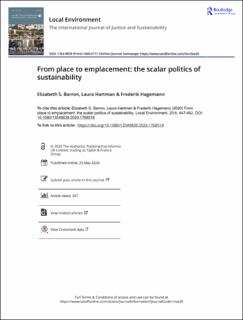| dc.contributor.author | Barron, Elizabeth | |
| dc.contributor.author | Hagemann, Frederik | |
| dc.contributor.author | Hartmann, Laura | |
| dc.date.accessioned | 2020-06-05T08:45:24Z | |
| dc.date.available | 2020-06-05T08:45:24Z | |
| dc.date.created | 2020-06-03T22:51:35Z | |
| dc.date.issued | 2020 | |
| dc.identifier.citation | Local Environment : the International Journal of Justice and Sustainability. 2020, 25 (6), 447-462. | en_US |
| dc.identifier.issn | 1354-9839 | |
| dc.identifier.uri | https://hdl.handle.net/11250/2656913 | |
| dc.description.abstract | Sustainability has emerged as a central concept for discussing the current state of the human-environment system and planning for its future. To delve into the depths of sustainability means to talk about ecology, economy, and equity as fundamentally interconnected. However, each continues to be colonised by normative epistemologies of ecological sciences, neoclassical economics, and development, suggesting that with enough science and development, a more equitable sustainability is achievable. In our analysis, place emerges as an alternative epistemology through which to analyze sustainability. Place exists at multiple spatial and temporal scales, understood through direct observation of boundaries, processes and patterns, phenomenologically through individual experience, and as a complex hybrid: always emerging through interactions among individuals and institutions. Despite the ubiquity of place in the socio-ecological literature, the complexity of place in relation to sustainability is under-theorised, and in as much as sustainability happens or does not happen in real places rather than in policies and models, a place-based sustainability framework is necessary to move forward. To address this gap, we developed the emplacement framework, consisting of four domains: displacement, misplacement, replacement, and emplacement. Each domain is dynamic, constructing place as praxis, and reframing sustainability as a site of collective inquiry and choices. Our goal is to facilitate the active and on-going practices of place-based research and engagement among scholars, activists, and other community members by providing a structure for transdisciplinary dialogue and the application of transdisciplinary research to enable better decision-making. | en_US |
| dc.language.iso | eng | en_US |
| dc.publisher | Taylor & Francis | en_US |
| dc.rights | Attribution-NonCommercial-NoDerivatives 4.0 Internasjonal | * |
| dc.rights.uri | http://creativecommons.org/licenses/by-nc-nd/4.0/deed.no | * |
| dc.title | From Place to Emplacement: The Scalar Politics of Sustainability | en_US |
| dc.type | Peer reviewed | en_US |
| dc.type | Journal article | en_US |
| dc.description.version | publishedVersion | en_US |
| dc.source.pagenumber | 447-462 | en_US |
| dc.source.volume | 25 | en_US |
| dc.source.journal | Local Environment : the International Journal of Justice and Sustainability | en_US |
| dc.source.issue | 6 | en_US |
| dc.identifier.doi | 10.1080/13549839.2020.1768518 | |
| dc.identifier.cristin | 1813733 | |
| dc.description.localcode | © 2020 The Author(s). Published by Informa UK Limited, trading as Taylor & Francis Group This is an Open Access article distributed under the terms of the Creative Commons Attribution-NonCommercial-NoDerivatives License (http://creativecommons.org/licenses/by-nc-nd/4.0/), which permits non-commercial re-use, distribution, and reproduction in any medium, provided the original work is properly cited, and is not altered, transformed, or built upon in any way. | en_US |
| cristin.ispublished | true | |
| cristin.fulltext | original | |
| cristin.qualitycode | 1 | |

